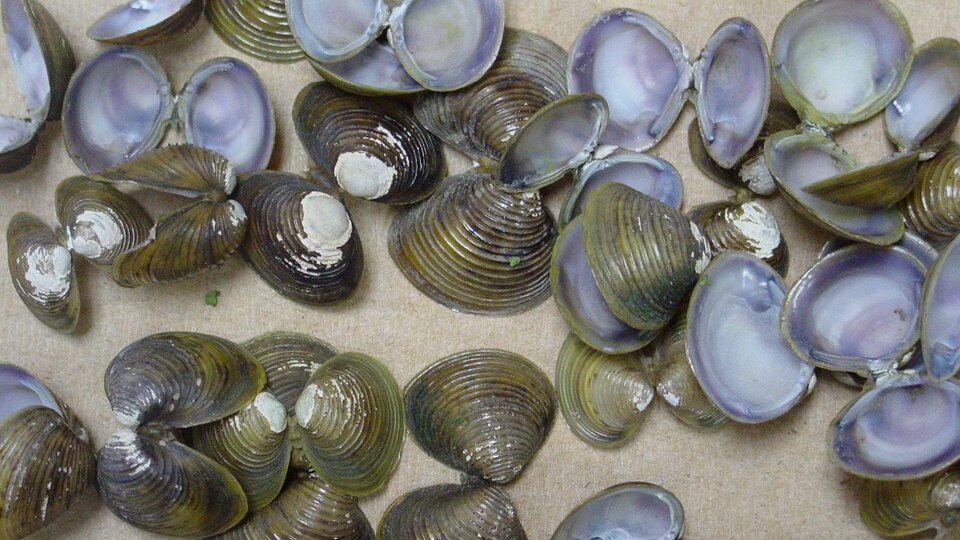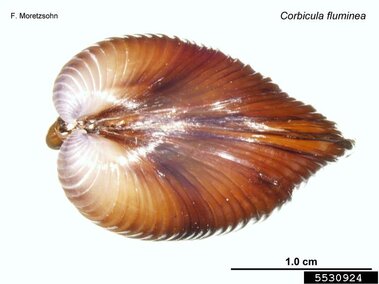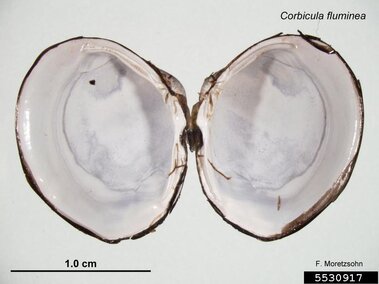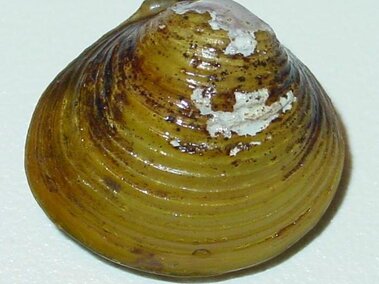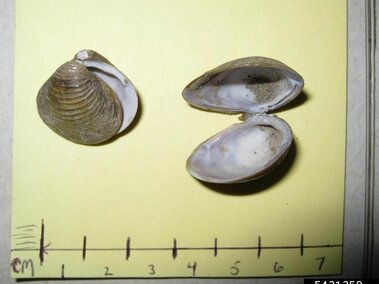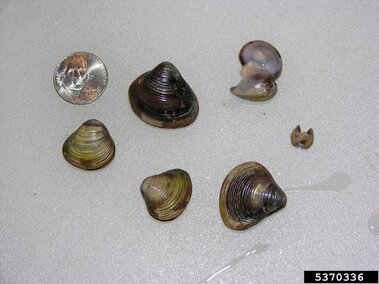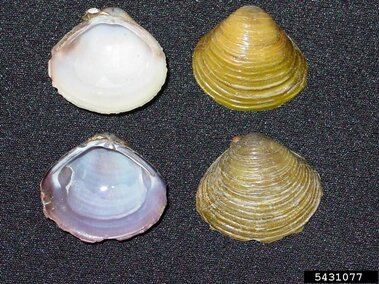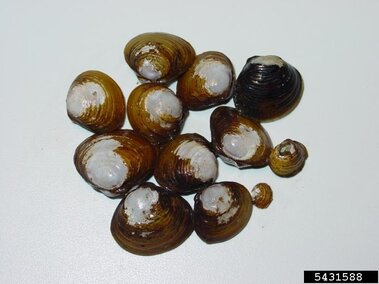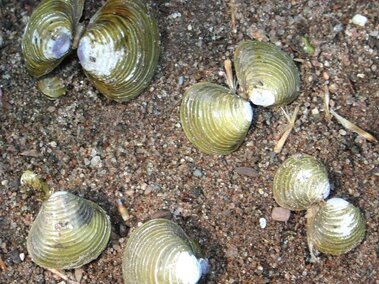General Information
Species Name: Corbicula fluminea
Also Known As: Asian clam, Asiatic clam, Asian freshwater clam, basket clam, Chinese basket clam, golden clam, good luck clam
Family: Cyrenidae (Basket Clam)
Life Span: 3-4 years
Life Cycle: Freshwater golden clams can be male, female, or both male and female. They are capable of both cross and self‐fertilization, so it only takes 1 individual to start a population. Adults typically reproduce two times a year, producing 1000 – 100,000 juveniles per year. Egg fertilization is internal and the larval clams are brooded on the gill where they transform into juveniles in about 4-5 days. Juveniles are tiny (0.25mm) and are capable of long distance dispersal via stream transport and water currents, or hitchhiking on animals, floating objects, or vegetation. The juveniles transform into a shelled juvenile equipped with a foot and settle to the bottom at about 0.25 mm in size. They can crawl around along the bottom and seek firm substrates where they attach (at about 1.0 to 1.5 mm in size). Juvenile clams can reach maturity in 3‐6 months or about 6-10 mm in size, and reach 10 to 30 mm in size during their first year depending on food availability and temperatures.
Origin: Asia, Africa, and Australia
Injurious: No
Category 3: Established Aquatic Invasive Species
Why Are They Invasive?
As a rapidly reproducing and quickly spreading filter-feeder its economic and ecological impacts on freshwater and estuarine systems have been diverse and complex. It can increase water quality and act as a new food resource for other species, but has caused millions of dollars worth of damage to intake pipes used by power, water, and other industries. Many native clams are declining as freshwater golden clams outcompete them for food and space. Many native fish and crayfish have added this clam to their diets, which means it could potentially be a vector for exotic parasites or diseases that could then infect native species.
What Do They Look Like?
Freshwater golden clams are usually less than an inch in size with a light-colored shell with well-defined, concentric grooves. The shell shape is triangular to round, and the color ranges from yellowish to light green or light brown. Dark shell morphs exist but are limited to the southwestern United States. The shells of the yellow morphs are straw yellow on the outside and white on the inside; those of brown morphs are dark brown and purple.
Photos
Where Do They Live?
Freshwater golden clams are filter-feeders on microscopic plants, animals (including bacteria) and in the water column or in the sediments, so they live in freshwater and estuarine sediment surface or slightly buried in the sediment. They are found in found in lakes and streams of all sizes with silt, mud, sand, and gravel substrate and prefer cooler waters. They can tolerate salinities of up to 13 ppt for short periods and temperatures between 2 and 30 degrees Celsius, or 86 degrees Fahrenheit. They prefer fine, clean sand, clay, and coarse sand substrates. They are usually found in moving water because it requires high levels of dissolved oxygen, and are generally intolerant of pollution.
How Do They Spread?
Freshwater golden clams were first reported in the United States in Washington's Columbia River in the 1930s. They were likely introduced intentionally for harvest and consumption purposes. They have since spread mostly through human activities, such as bait bucket dumping, aquarium releases into streams or canals, and intentional releases by people who bought the clams at food markets. Freshwater golden clams may also have been introduced accidentally in shipments of imported aquaculture species. Another pathway for dispersal is the passive movement of larvae in water currents.
How Do I Control Them?
Contact the Nebraska Game and Parks Commission to determine appropriate control methods. To prevent their spread and introduction into your waterbodies:
CLEAN your watercraft, trailer, angling gear and other equipment. Remove all aquatic vegetation and animal species from your equipment.
DRAIN your watercraft at the ramp by removing the boat plug and draining all live wells and ballast tanks.
DRY your watercraft, trailer and other equipment for at least 7 days before visiting another waterbody.
DON'T DUMP BAIT. Dispose of bait by emptying bait buckets on dry land, away from waterbodies or in a trash receptacle. Moving a live organism from one waterbody to another is illegal, even if you are planning to use the organism as bait.
DON'T LET IT LOOSE. Do not release or transport exotic or non-native fish species to new ecosystems. It is unlawful to release any aquatic species into a waterbody other than the one from which it was harvested. Doing so can promote the spread of AIS.
What Should I Do If I See Them in Nebraska?
If you see freshwater golden clams in Nebraska, you should report them to the Nebraska Game and Parks Commission's Aquatic Invasive Species (AIS) Program using their AIS Report Form. For guidance on what information to include in your report, check out our reporting tips.
References and More Information
Center for Invasive Species and Ecosystem Health
Global Invasive Species Database
Midwest Invasive Species Information Network
National Invasive Species Information Center
Nebraska Game and Parks Commission
New York Invasive Species Information
Smithsonian Environmental Research Center
South Carolina Department of Natural Resources
Summary of Species Currently Listed as Injurious Wildlife under (18 U.S.C. 42) Lacey Act
